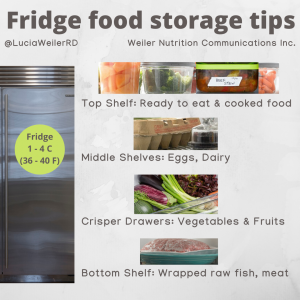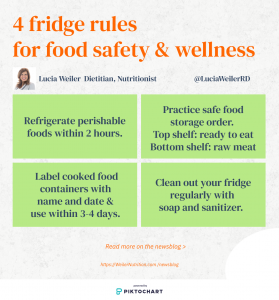4 Fridge rules for food safety & wellness
Can you think of a time when you found something in your fridge you did not recognize? Or a special food you bought was misplaced only to turn up spoiled? Well you’re not alone! In today’s busy home kitchens these things happen. As a dietitian and food safety professional I can offer you some evidence based advice to help you keep your food cool safely, save you money and reduce waste. Follow these tips for safe food storage in your fridge.
1. Refrigerate perishable foods promptly.
After shopping or cooking how do you put food in the fridge? You may be surprised to discover there is a recommended safe way to store perishable foods.
- When you return home from shopping put perishable foods in the fridge quickly. Follow the safe food storage tips outlined in this article.
- If you have extra food after cooking refrigerate leftover foods within two hours. Use clear shallow containers or baggies to store leftovers. Pro tip: separate larger amounts of leftovers into small, shallow containers for quicker cooling in the refrigerator.
2. Label cooked food containers with name of the food and date you made them.
It’s a lot to ask sometimes to remember when you ate that leftover food that’s sitting in your fridge. To help jog your memory try these foodservice professional’s practices.
- Place a label on the food containers with the name and date when you made them before putting them in the fridge. Keep a roll of masking tape and a marker handy.
- Use clear containers with a lid to protect the food and see what is in it.
Leftovers are safe in the fridge for 3-4 days. If you don’t have a chance to eat leftovers within this time, move them to the freezer for later use.
3. Practice safe food storage order.
Did you know there is a best way ‘hierarchy’ to store perishable foods in your fridge? Here are the foodservice pro’s fridge rules to keep foods safe and organized.
- TOP SHELF – Keep ready to eat fully cooked leftovers here so they are at eye level. Remember to eat leftover foods within 3-4 days of cooking or move them to the freezer.
- MIDDLE SHELVES: The mid-section of the fridge is best for dairy such as milks, cheeses, yogurt and butter, eggs.
- BOTTOM SHELF – RAW / uncooked MEAT: Store uncooked fish, meat at the bottom – lowest shelf or meat drawer. To prevent juices from leaking and cross contaminating other foods, store raw fish, meat and poultry wrapped and place it on a plate or in a sealed container.
- CRISPER DRAWERS – These sealed compartments are specially designed to keep the humidity right for veggies and fruit. Remember fresh fruit, many vegetables and herbs are perishable and require refrigerated storage to keep them fresh longer.
- Mind the doors. The temperature in the door is not always consistent. So play it safe and keep items that don’t spoil easily, such as condiments, in the fridge door.

4. Clean your fridge regularly and keep it in good running condition.
A fridge is often a ‘taken for granted’ appliance and giving it a little attention helps keep it running well. After all it stores hundreds of dollars’ worth of food that must be kept cold so it doesn’t spoil as fast and make us sick.
- Declutter your fridge contents regularly. An overstuffed fridge restricts airflow and it may hinder proper cooling. Toss out items that are past their prime and keep foods that are before their expiration date.
- Clean out your fridge regularly. It’s not enough to just wipe up the obvious messes. Wash down shelves and drawers with soapy water and use a sanitizer to reduce germs.
- Monitor your fridge’s temperature – it should be between 1-4 degrees Celsius (36-40 Fahrenheit.) Keep a backup thermometer in your fridge for food safety.
Watch my one minute VIDEO summary and tips on the 4 Fridge Rules here:
If you can implement some of these savvy fridge food storage tips, you’ll be well on your way to keeping your food safe, wasting less food and saving more of your money. Good luck and if you have any questions or would like more information contact us at Lucia@weilernutrition.com
